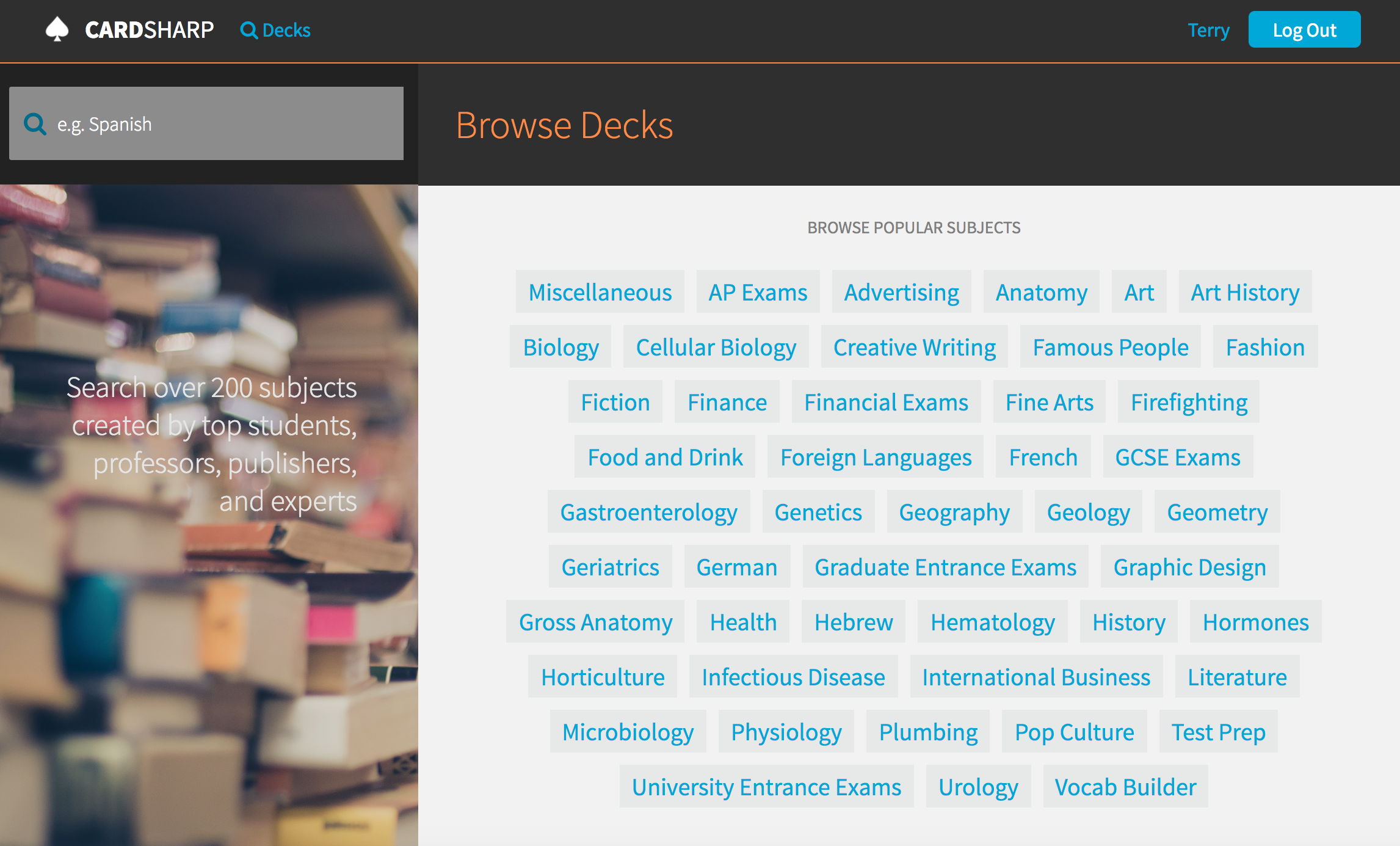CardSharp is a full-stack web application inspired by the flash card site Brainscape. It has a Rails backend with a PostgreSQL database and a React/Redux frontend.
Users must be logged in to create decks and cards, although anyone can search and inspect them.
Decks enter the database with a title, optional description, author_id, and
is_private boolean (defaulting to false). Cards are stored with side_a and
side_b attributes along with a deck_id. On creating a deck, users are sent
to that deck's edit page to add, edit, or delete cards.
On the frontend, decks are kept in the decks slice of Redux state. When a user
is searching decks by tag, decks contains information on the decks with the
searched tag; when a user is looking at his or her profile page, decks shows all
the decks made by that user in addition to those made by others that the user has
subscribed to. If a user is editing or studying a deck, more detailed information
is kept in the Redux store's deckShow, including the deck's cards.
card_item.jsx
dragStart(e) {
e.dataTransfer.setData("cardId", e.target.dataset.id);
}
// ...
render() {
return (
<li className="card" data-id={id} draggable onDragStart={this.dragStart}>...</li>
)
}trash_card.jsx
onDrop(e) {
e.preventDefault();
const cardId = e.dataTransfer.getData("cardId");
this.props.deleteCard(cardId);
}Originally, cards were stored with a mastery attribute--a number 1 through 5
representing the deck owner's mastery of that card's material, updated every
time the deck owner studied that particular card. When the time came to allow
users to subscribe to and train others' decks, I realized that this model wouldn't
work--a card's mastery would be rewritten every time another user studied it. To
address this, I built a separate Mastery model (with card_id, user_id, and a
value 1 through 5): the deck creator along with subscribed users train on the
same deck with the same cards, but each has a separate mastery item to track
his or her individual progress on the deck.
This feature is only available to logged-in users. Users choose a deck to study (it must have cards--empty decks are unavailable for training) and are sent to a pared-down interface where they can flip between the front and back of cards in that deck one at a time. A bar on the side keeps track of the user's progress through the deck and has buttons to switch between decks to study and to return to the profile page.
In the original iteration of the deck train feature, when users switched from
studying one deck to studying another, the progress shown in the sidebar wouldn't
update. If the switch happened when the last card in the previous deck was showing
its side_b (the answer), users would see the same side of the new deck's first
card, even though it should automatically show side_a. I solved this by adding
state to the deck train component: when the deck switches, the state is set back
to card 0, prompting a rerender and effectively restarting study progress.
Another small bug: originally, the card item represented in study mode had a distinct front side and back side; it flipped forward (right) to reveal the answer on the back and backward (left) to review the question. When a new card replaced the old, however, users would see a flash of the answer to the new card before it had finished flipping back to the question side. I solved this by modifying the flipping mechanism: moving on to the next card doesn't prompt a flip, so the back of one card is outright replaced by the front of the next card. Maintaining the front/back, flip-forward-for-answer/ flip-backward-for-question dichotomies would have been possible, but it was simpler to just dissolve the front-of-card and back-of-card distinctions and have the card flip forward irrespective of whether it was switching from the back to the front or vice versa.
Tags are stored in the database with just a name attribute. The join table
Taggings (with deck_id and tag_id attributes) allows a deck to be associated
with several tags and a tag to be associated with several decks.
Tags are stored on the frontend in the tags slice of Redux state. When a particular
tag is searched for, the Redux state's tagShow is updated with that tag's name
and id and decks is updated with the decks having that tag.
When users create or edit decks, they can choose to add or remove tags--either preexisting tags or tags of their own creation.
def tag_names=(tag_names)
self.tags = tag_names.map do |tag_name|
Tag.find_or_create_by(name: tag_name)
end
endThe search page initially shows the most popular tags across the site. Users can then search tags, both CardSharp- and user-created, to find others' decks that they're interested in studying. From the search interface, they can choose to subscribe or unsubscribe to those decks. Subscribed decks will then appear on the user's profile page alongside the decks he or she created. I implemented the search function's autosuggest through the react-autosuggest NPM package.
With CardSharp, there are many more avenues to explore. My next steps are as follows:
Users should be able to upload images to cards in addition to text. I will use an AWS bucket to store them.
Badges will reward users for training regularly, for achieving mastery, and for creating popular decks.
I will use the Anki API to implement an optional spaced repetition scheme for users--CardSharp will calculate the best cards and decks for each user to study based on their past mastery and the amount of time since last training.
Users will be able to list each other as friends and compete with each other to attain better mastery.

